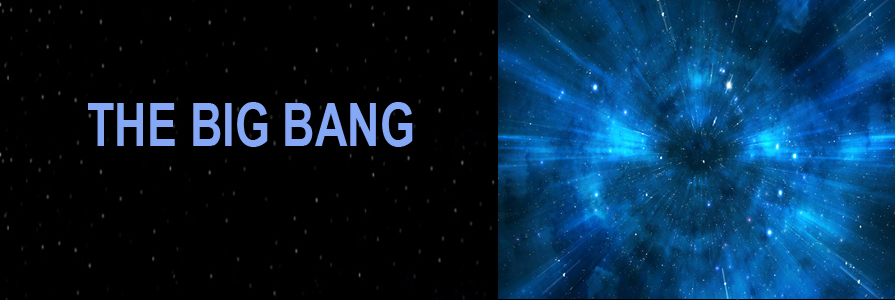
Edwin Hubble Ushers In Modern Cosmology (the study of the universe as a whole)

Until the 1920's, scientists thought that the universe was in a "steady state". The Steady State Universe Theory was based on three assumptions, i.e. the universe was:
- Uniform - has the same general make-up throughout
- Static - not expanding or contracting
- Infinite - it extends forever, but there was only one galaxy - The Milky Way
If you look at the night sky, it seems easy to think that this is the way the universe "has" always looked and "will" always look. However, there was a problem pointed out by Heinrich Olbers in the 1800's - if the universe were infinitely large and infinitely old, then the whole sky should have a "glow". That is, at all points of sight there would eventually be a star. If the universe was "infinitely old" then the light from any star at any distance would have already reached us no matter how far the distance. So all points in the heavens should have some light. However, the the sky between stars was "very dark", with no signs of any glow. This became known as Olbers' Paradox, but no one took the "obvious" solution seriously. In retrospect, the solution was that "the universe was expanding" and was not "infinitely old".
In 1922 to 1924, Edwin Hubble painstakingly developed a series of nebulae distance indicators using the 100 inch Hooker telescope at Mount Wilson Observatory in California. At the time Mount Wilson was the world's largest telescope. Edwin Hubble, then a thirty-five year old scientist, presented a paper in January,1925 that proved conclusively that the some of the faint
stellar objects were much too distant to be part of our galaxy and were in fact "galaxies outside the Milky Way". In 1922, Alexander Friedmann, a Russian cosmologist and mathematician, derived the Friedmann Equations from Albert Einstein's equations of General Relativity. In 1924 Friedman published a paper indicating that the universe must be either expanding or contracting, but not static.
In 1927, George Lemaître, a Belgian physicist and Roman Catholic priest, interpreted Friedman's equations and proposed that the recession of nebulae was due to the "expansion of the universe". (Back then the word nebulae meant galaxies outside the Milky Way; today nebulae means large clouds of gas and dust.) However, both Friedman and Lemaître were mostly dismissed, even by Albert Einstein. But, in 1929 Hubble discovered a correlation between "nebulae distance and recession velocity" which meant that indeed "the universe was expanding", a shock to most scientists of that time.
Hubble's discoveries came to be known as Hubble's Law, which is: (a) all objects in deep space have a red shift (see xxxx) relative to earth and to each other; and (b) the velocity of galaxies receding from earth is proportional to their distance from the earth and other interstellar bodies. Top
An Expanding Universe Implies A Tiny Beginning - The Big Bang
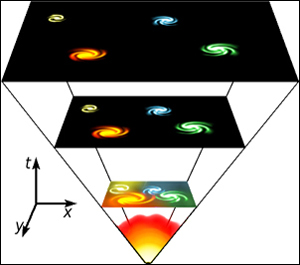
In 1931 Georges Lemaître further postulated that the expansion of the universe, if projected back in time, would make the universe smaller and smaller until at some finite time (now estimated at 13.8 billion years ago) all the mass of the universe would be concentrated in a single point about the size of a ping pong ball. In 1949, Sir Fred Hoyle, an English astronomer and mathematician, coined the term The Big Bang in a BBC radio broadcast regarding the early growth of the universe. It immediately gained popularity and has since become the standard term for the universe's early growth period.
While believing that the universe was expanding, many scientists at the time could not accept that the universe began from a single point, known as a singularity in mathematics. Even Albert Einstein was among the doubters and had originally introduced a "Cosmological Constant" into his equations so that the universe would continue to be in a "steady state". He put the cosmic repulsion into his equations to prevent the universe from collapsing on itself from the gravitational pull of the matter inside it.
Theories were put forth to explain how the universe could be unchanging while the galaxies were moving away from each other. These theories suggested the creation of matter between galaxies over time, so that even though galaxies grew further apart, new ones developed between them to fill the spaces they left behind. The resulting universe was in a "steady state" in the same manner that a flowing river is - the individual water molecules are moving away but the overall river remains the same.
When Edwin Hubble discovered that the universe was expanding, Einstein retracted his Cosmological Constant, calling it the biggest mistake of his life. From that point forward, the scientific view has been that the universe is indeed expanding.
The discovery of the Cosmic Microwave Background (CMB) in the 1960's convinced most astronomers that the Big Bang Theory had merit. The "Hubble Expansion" is now one of three pieces of evidence that support the Big Bang Theory. (The other two are the Cosmic Microwave Background and Big Bang Nucleosynthesis.) Top
Issues With The Original Big Bang Theory
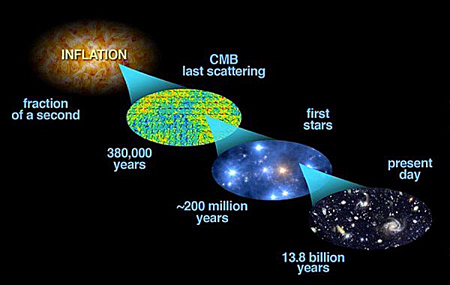
The Big Bang Model has been extremely successful at explaining various aspects of the universe and has correctly predicted new observations. However, there were some issues associated with the original Big Bang Theory. These difficulties were not so much errors as they were assumptions that were somewhat arbitrary. The following three issues are somewhat picky but nevertheless bothersome:
-
The definition of a "horizon" in cosmology is the inability to receive any type of signal from a very distant source because of the finite speed of light. The microwave background radiation coming from extremely distant parts of the universe all have exactly the same average temperature but are too far apart to have ever communicated with each other, even with signals traveling at the speed of light. Temperatures of the background radiation were just "assumed" to be the same everywhere in the original Big Bang Theory. Hence the "horizon issue" - How did the temperatures get to be exactly the same everywhere?
-
Based on Einstein's General Relativity, the original Big Bang Theory assumed that the universe was "mathematically flat" (explained in the next paragraph) in all directions. If not "flat", it would have collapsed on itself shortly after the Big Bang or it would have flown apart so quickly that galaxies would never have been able to form. The original Big Bang required the universe to be flat within one part in 10^59 (one with 60 zeros following it). This is obviously possible but is it realistic?
The term "flat" is a mathematical term that represents the rate of expansion of the universe, meaning the expansion rate will neither increase or decrease, i.e. it will remain the same (or be "flat"). Being mathematically "flat" has nothing to do with the shape of the universe, it is a term to describe (poorly) the rate of expansion in all directions. It means the universe is a spherical type object expanding equally fast in all directions sort of like blowing up a balloon.
-
Current theory of sub-atomic particle physics predicts that very massive exotic particles called magnetic monopoles should have been produced by the Big Bang. There should be many of these monopoles in the universe today. However, no one has ever found any monopole particles. Any particle left over from the early, hot stages of the universe is called a "relic particle". The big bang model predicts that we should be able to observe these relic particles today, but none have ever been seen. Top
Big Bang Inflation
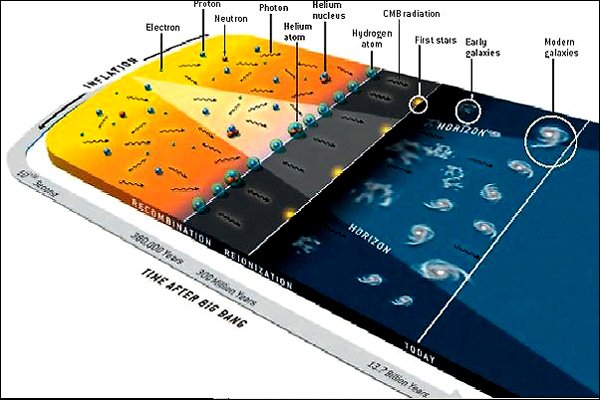
In the Big Bang model, time is run backwards according to General Relativity until the universe reaches a critical density called the Plank Density. General Relativity ceases to be valid when the density of the universe exceeds the Planck Density which is 5 x 10^93 grams per cubic centimeter. This is an enormous number - roughly 100 billion galaxies squeezed into the size of an atomic nucleus! Beyond this point Einstein's equations are meaningless, the laws of physics breakdown, and so we can not project anything earlier than this time. The Plank Density occurred at just 10^-43 of a second after the Big Bang and anything earlier than this can not be explained by modern day physics.
Inflation Theory, initially developed in 1981 by Alan Guth of MIT, and extended by Andrei Linde, Paul Steinhardt, and Andy Albrecht, introduces a period of extremely rapid (exponential) expansion of the universe prior to the more gradual Big Bang expansion. Inflation was extremely rapid, it increased the size of the "observable" universe by a factor of about 10^70 in only a small fraction of a second! Note in the chart above that the "horizons" define the "observable" universe, which is the amount of space that the speed of light has traveled from the Big Bang until now. We do not know what exists in the space beyond the "observable" universe. Also note that the universe was not expanding into empty space. Space-time itself was growing faster than the speed of light. Space-time is not limited by the speed of light, only objects "within" space-time are.
Inflation is now considered an extension of the Big Bang theory since it explains the above issues very well while retaining the basic concept of a homogeneous expanding universe. Here is how the above three issues are explained by Inflation:
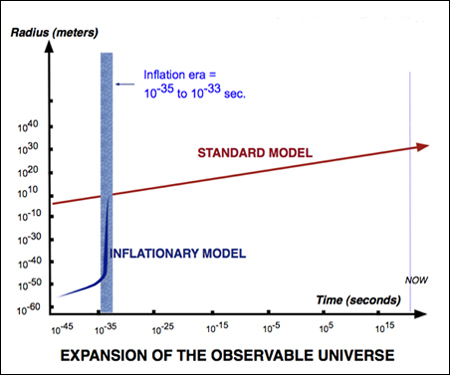
-
The tremendous expansion of inflation means that regions that we see widely separated in the sky now were much closer together before inflation and thus could have been in contact.
-
Inflationary Theory predicts unequivocally that the universe should be exactly flat. The universe appears to be flat out to the farthest distance that we can see. The satellite WMAT found the universe to be "flat" with an error of only plus or minus 0.5%.
-
The rapid expansion of the universe tremendously diluted the concentration of any magnetic monopoles that might have been produced. Calculations indicate that they have become so rare in any given volume of space that it would be very unlikely to ever encounter one in an experiment to search for them.
As a bonus, Inflation also explains the structure of the current universe. Prior to Inflation, the portion of the universe we can "observe" was microscopic. Quantum fluctuations in the density of matter on microscopic scales expanded to astronomical scales during Inflation. Over the next several hundred million years, these higher density regions condensed into stars, galaxies, and clusters of galaxies in the universe as we now know it. While Inflation at this point is still a "theory" because there is no hard evidence of it. Many years from now if Inflation is not part of the of the early universe theory, then it will probably have been replaced by something quite similar. Top
Polarization Evidence Of Early Cosmic Inflation
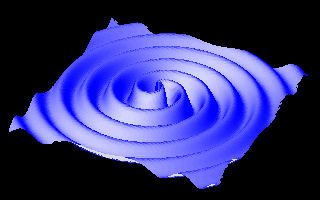
Inflation increased the size of the "observable" universe by a factor of about 10^70 in only a tiny fraction of a second. All this was just theory until March of 2014. Researchers from the BICEP (Background Imaging of Cosmic Extragalactic Polarization) collaboration announced the first direct evidence for cosmic inflation. Their data also presents the first images of gravitational waves, tiny ripples in space-time.
Gravitational waves are small ripples in the fabric of space-time that Einstein predicted. Gravitational waves are disturbances in space-time caused by large motions of matter such as the universe rapidly expanding in a 10^-32 second of time. They are minuscule ripples in the fabric of the universe that carry energy across space, somewhat similar to waves crossing an ocean. Propagating at (or near) the speed of light, gravitational waves do not travel "through" space-time as such, the fabric of space-time itself is "oscillating" as in the animation. Though gravitational waves pass straight through matter, their strength weakens in proportion to the distance they travel from the source. A gravitational wave arriving on earth will alternately "stretch and shrink distances", but on an incredibly small scale. Gravitational waves are believed to be about one thousandth the diameter of a proton.
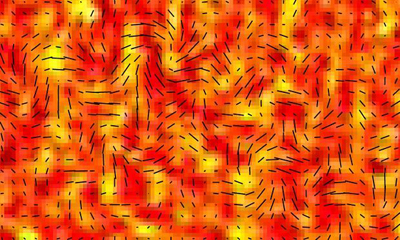
Since the cosmic microwave background is a form of light, it exhibits all the properties of light, including polarization. On earth, sunlight becomes polarized by passing through the atmosphere, which is why polarized sunglasses help reduce sun glare. In outer space, the early Cosmic Microwave Background (CMB) was scattered by dense atoms and electrons and became polarized too. Inflation gravitational waves made their imprint on the cosmic microwave background that can be seen today. As a result of this imprint, there are patches of sky in which the CMB’s polarization goes one way, and other patches in which the polarization goes the opposite way. The Harvard-Smithsonian Center for Astrophysics (CfA) team using the BICEP2 telescope has constructed a very detailed map of the polarization of the CMB in a small patch of the southern sky. See the image to the left.
The yellow areas correspond to one direction of polarization and the red areas correspond to another direction of polarization. It is the width and the number of the swirling yellow and red patterns (called "B mode polarization") that relates to inflationary theory. The theory predicts that if inflation happened and if it produced large-scale gravitational waves, the number and widths of the yellow and red swirls that have been detected by the CfA team, should correspond to the predictions of the theory of inflation and "they do". The imprint is much heavier than expected. "This has been like looking for a needle in a haystack, but instead we found a crowbar," said co-leader Clem Pryke of the University of Minnesota. Top
The BICEP2 Telescope
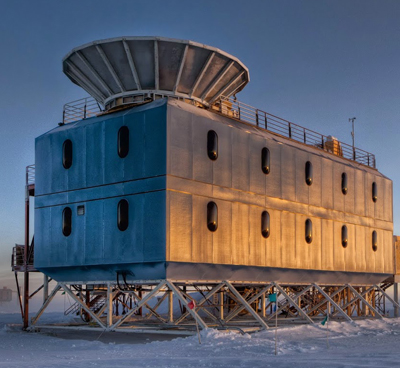
The BICEP2 scope has an aperture slightly less than 12 inches, but it does not need to be big. Cooled to 4 Kelvin, it gazes at a 20° patch of sky 24/7, detecting the CMB’s faint microwaves and, crucially, how they’re polarized. See the South Pole photo of the BICEP2 telescope to the left.
This was a three year effort because the majority of time was spent by the scientists involved proving to themselves that the polarizations were not due to extraneous factors or errors. The observations were done at the South Pole to take advantage of its cold, dry, stable air. The BICEP team considered whether dust in the Milky Way could have produced the observed pattern, but the data suggest that this was highly unlikely. They also looked at the possibility of the polarization being generated by Gravitational Lensing. However, the primordial gravity waves can be separated because they have large angular scales. Gravitational lensing B modes exist at an angular scale only one-tenth that of the primordial ones and therefore can be extracted from the data.
After ruling out more than a dozen alternate explanations, the team is confident that they have recorded the imprint of inflation in the sky. In statistical terms, their signal is better than 5 sigma, which is the gold standard a detection has to meet before physicists accept it as a discovery.
Another important part of the discovery: this was the first time that quantum properties of gravity have been directly observed providing a link from quantum mechanics theory to gravity theory. This is the first hard evidence that gravity itself is "quantized", meaning it comes in discrete packets as light does. The gravitational waves that produced the B modes were born as quantum fluctuations in gravity itself. Quantum theory implies that on an extremely tiny microscopic scale, everything is in a state of constant agitation, including gravity. See the "quantum-gravity era" in the illustration below. These extremely tiny gravitational fluctuations then got stretched by inflation and subsequent universe expansion into humongous waves billions of light years across, that can now be "seen" with very powerful telescopes. “I think this is the only observational evidence that we have that actually shows that gravity is quantized,” says cosmologist Ken Olum of Tufts University.
What could be the driving force of such an extreme expansion such as cosmic inflation? An expansion in spatial scale of 10^26 in 10^-32 of a second is not like any known energy source. There is a wealth of theoretical possibilities on the topic, but nobody really knows. However, with the discovery of dark energy, that has been proven to accelerate the universe's current expansion, the Big Bang Theory of Inflation now sounds less like theoretical speculation and more like something that can be believed.
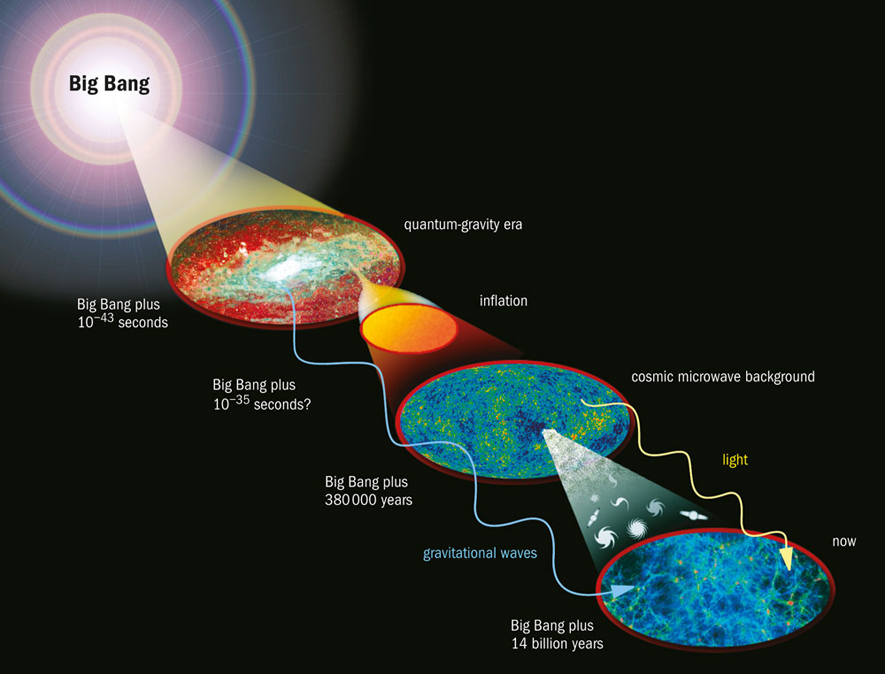
The results do not tell us anything about what occurred before the Big Bang Inflation, only that it happened. They also do not answer the question of whether inflation is "eternal", setting off an endless series of big bangs creating many universes. This cosmological train of thought is referred to as the "multiverse" scenario. See the Branes And Multiverse section.
Now that a surprisingly strong polarization pattern has been found, this discovery must be confirmed by an independent study before it is completely accepted by the scientific community. If corroborated, the media predicts that the team of astro-physicists led by John Kovac of the CfA will receive a Nobel Prize for their outstanding discovery. The New York Times said, "Confirming inflation would mean that the universe we see, extending 14 billion light years in space with its hundreds of billions of galaxies, is only an infinitesimal patch in a larger cosmos whose extent, architecture and fate are unknowable." Top
Subsequent BICEP2 Events
The BICEP2 findings have received a major setback from researchers with the European Space Agency’s Planck mission and other noted scientists, who have studied the issues and who claimed in a subsequent paper that galactic dust "could" fully explain the BICEP2 observations. “It is certainly possible that the results can be explained purely by dust,” said Jo Dunkley, professor of astrophysics and a member of the Planck team at Oxford University. “Our work does not rule out the possibility that they have gravitational waves, but there is dust in there and it seems to be higher than thought.”
Cosmologists have always known that clouds of dust spewed from exploding stars can mimic the signature of gravitational waves. Space dust is heated up by starlight but re-emits the radiation as infra-red light. This light gets twisted because dust particles align themselves with the huge magnetic field that stretches through the plane of the Milky Way. The Planck team’s results do not rule out the BICEP2 findings, but makes clear how much dust has to be accounted for.
Andrew Pontzen, an independent cosmologist at University Cambridge London, said the Planck paper added to the weight of evidence that seemed to be going against the BICEP2 result. “A fair-minded person would now say that the prevailing wind is against BICEP2. Their result is not completely dead though. What you can say for sure is that the original analysis was insufficient to say the signal is really there. It doesn’t mean for sure that they haven’t seen anything,” said Pontzen.
In an attempt to come to a scientific conclusion, the Planck and BICEP2 teams have agreed to share their data in a new collaboration.